Olive Trees (Van Gogh series)
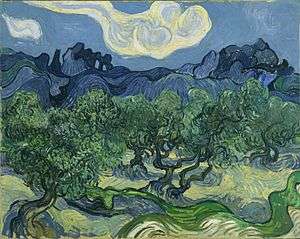 | |
| Artist | Vincent van Gogh |
|---|---|
| Year | 1889 |
| Catalogue | F712 / JH1740 |
| Medium | Oil on canvas |
| Dimensions | 92 cm × 72.5 cm (36.2 in × 28.5 in) |
| Location | Museum of Modern Art[1][2], New York, NY |
Vincent van Gogh painted at least 18 paintings of olive trees, mostly in Saint-Rémy-de-Provence in 1889. At his own request, he lived at an asylum there from May 1889 through May 1890 painting the gardens of the asylum and, when he had permission to venture outside its walls, nearby olive trees, cypresses and wheat fields.
One painting, Olive Trees in a Mountainous Landscape, was a complement to The Starry Night.
The olive tree paintings had special significance for van Gogh. A group in May 1889 represented life, the divine and the cycle of life while those from November 1889 arose out of his attempt to symbolize his feelings about Christ in Gethsemane. His paintings of olive pickers demonstrate the relationship between man and nature by depicting one of the cycles of life, harvesting or death. It is also an example of how individuals, through interaction with nature, can connect with the divine.
Van Gogh found respite and relief in interaction with nature. When the series of olive tree paintings was made in 1889 he was subject to illness and emotional turmoil, yet the paintings are among his finest works.
Saint-Rémy

Collection of Elizabeth Taylor (F803)
In May 1889, Van Gogh voluntarily entered the asylum[3] of St. Paul[4] near Saint-Rémy in Provence.[5] There he had access to an adjacent cell he used as his studio. He was initially confined to the immediate asylum grounds and painted (without the window bars) the world he saw from his room, such as ivy covered trees, lilacs, and irises in the garden.[3][6] As he ventured outside of the asylum walls, he painted the wheat fields, olive groves, and cypress trees in the surrounding countryside,[6] which he saw as "characteristic of Provence." Over the course of the year, he painted about 150 canvases.[3]
The imposed regimen of asylum life gave van Gogh a hard-won stability: "I feel happier here with my work than I could be outside. By staying here a good long time, I shall have learned regular habits and in the long run the result will be more order in my life."[6] While his time at Saint-Rémy forced him to manage his vices, such as coffee, alcohol, poor eating habits and periodic attempts to consume turpentine and paint, his stay was not ideal. He needed to obtain permission to leave the asylum grounds. The food was poor; he generally ate only bread and soup. His only apparent form of treatment were two-hour baths twice a week. During his year there, van Gogh had periodic attacks, possibly due to a form of epilepsy.[7] By early 1890, when the attacks worsened, he concluded that his stay at the asylum was not helping him to recover, which led him to move to Auvers-sur-Oise just north of Paris in May 1890.[8]
Olive trees as a subject
Painting the countryside, the surrounding fields, cypress trees and olive trees restored van Gogh's connection to nature through art.[9] He completed at least 18 paintings in 1889[10] of "venerable, gnarled olive trees," pervasive throughout southern France,[11] of which he wrote:
- "The effect of daylight and the sky means there are endless subjects to be found in olive trees. For myself I look for the contrasting effects in the foliage, which changes with the tones of the sky. At times, when the tree bares its pale blossoms and big blue flies, emerald fruit beetles and cicadas in great numbers fly about, everything is immersed in pure blue. Then, as the bronzer foliage takes on more mature tones, the sky is radiant and streaked with green and orange, and then again, further into autumn, the leaves take on violet tones something of the color of a ripe fig, and this violet effect manifests itself most fully with the contrast of the large, whitening sun within its pale halo of light lemon. Sometimes, too, after a shower I've seen the whole sky pink and orange, which gave an exquisite value and coloring to the silvery gray-greens. And among all this were women, also pink, who were gathering the fruit."[12]
He found olive trees, representative of Provence, both "demanding and compelling." He wrote to his brother Theo that he was "struggling to catch (the olive trees). They are old silver, sometimes with more blue in them, sometimes greenish, bronzed, fading white above a soil which is yellow, pink, violet tinted orange... very difficult." He found that the "rustle of the olive grove has something very secret in it, and immensely old. It is too beautiful for us to dare to paint it or to be able to imagine it."[10]
Spiritual significance
As a young man, van Gogh was interested in pursuing ministry to serve working people.[13][14] He studied for a time in the Netherlands but his zeal and self-imposed asceticism cost him a short-term position in lay ministry. He became somewhat embittered and rejected the church establishment, yet found a personal spirituality that was comforting and important to him.[14] By 1879, he made a shift in the direction of his life and found he could express his "love of God and man" through painting.[13]
Van Gogh painted nature, the major subject for his works in the last 29 months of his life, to bring relief from his illnesses and emotional distress.[15] Prior to this period he had rejected what he perceived as the narrow religion of his parents, and took an almost nihilistic stance, not unlike Nietzsche's, toward religion and God.[16] It was among the blossoming trees, the olive orchards and fields that van Gogh most often found "profound meaning", because he saw in their cycles an analogy to human life. He wrote to Theo that death, happiness and unhappiness are "necessary and useful" and relative, declaring "Even faced with an illness that breaks me up and frightens me, that belief is unshaken."[8]
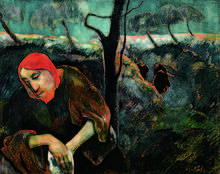
Note the red hair of the Christ / Gauguin self-portrait, the color of which has been described as "supernaturally red", and directly evokes van Gogh.[18]
The autumn work was somewhat in reaction to the recent compositions of Christ in the Garden of Olives by his friends Paul Gauguin and Émile Bernard.[19] Frustrated by their work which he qualified with the words "nothing was observed", Van Gogh painted "in the groves, morning and evening during these clear, cold days, but in beautiful, bright sunshine" resulting in five canvases above the three he completed earlier in the year.[20] He wrote to his brother, Theo, "What I have done is a rather hard and coarse reality beside their abstractions, but it will have a rustic quality and will smell of the earth."[19] Rather than attempting to recreate what the scene might have been like,[20] he explained "one can express anguish without making reference to the actual Gethsemane, and... there is no need to portray figures from the Sermon on the Mount in order to express a gentle and comforting feeling."[13] He also commented: "I shall not paint a Christ in the Garden of Olives, but shall paint the olive harvest as one might see it today, and by giving the human figure its proper place in it, one might perhaps be reminded of it."[13][21]
Analysis
Artistic style
Van Gogh's early works were made with dull, gray colors.[22] In Paris, he met leading French artists Edgar Degas, Georges Seurat and others who provided illuminating influences on the use of color and technique. His work, previously somber and dark, now "blazed with color." Indeed, van Gogh's use of color became so dramatic that he was sometimes called an Expressionist. But it was southern France that provided an opportunity for him to express his "surging emotions."[23] Enlightened by the effects of its sun-drenched countryside, van Gogh reported that above all, his work "promises color".[24] This is where he began development of his masterpieces.[23]
Van Gogh captured the colors and moods of the trees which varied dramatically by daylight and season.[12] He began to use the color blue to represent the divine. In both The Starry Night and his olive tree paintings, van Gogh used the intense blue of the sky to symbolize the "divine and infinite presence" of Jesus. Seeking a "modern artistic language" to represent the divine, he sought a numinous quality in many of his olive tree paintings, such as by bathing olive trees, an emblem for Jesus, in "radiant gold light".[25]
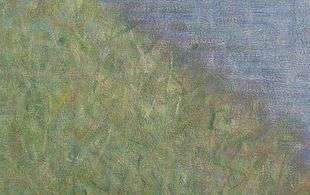
An example of use of Seurat's use of broken lines of color to bring light and form to paintings.
Van Gogh used the Impressionist concept of broken color to give light to a work, innovatively drawing in color, giving the painting light and form, as he also did in his paintings of plowed fields, mountains, rocks, and heads and figures.[26] The series is unified by a more refined approach, without the thick application of paint to which he was more accustomed.[19]
Meaning
The National Gallery of Art summarizes this series:
- "In the olive trees — in the expressive power of their ancient and gnarled forms — van Gogh found a manifestation of the spiritual force he believed resided in all of nature. His brushstrokes make the soil and even the sky seem alive with the same rustling motion as the leaves, stirred to a shimmer by the Mediterranean wind. These strong individual dashes do not seem painted so much as drawn onto the canvas with a heavily loaded brush. The energy in their continuous rhythm communicates to us, in an almost physical way, the living force that van Gogh found within the trees themselves, the very spiritual force that he believed had shaped them."[10]
Skye Jethani, author of The Divine Commodity: Discovering a Faith Beyond Consumer Christianity, asserts that in many of his paintings, the olive tree series in particular, van Gogh conveys the redemptive quality of sorrow and that even in sorrow, there can be rejoicing. To quote van Gogh's sermon of 1876:
- "Sorrow is better than joy... for by the sadness of the countenance, the heart is made better. Our nature is sorrowful, but for those who have learnt and are learning to look at Jesus Christ, there will always be reason to rejoice. It is a good word, that of St. Paul: as being sorrowful yet also rejoicing."[27]
The paintings
In his letters, van Gogh specified two groupings: three paintings made in June 1889 and five completed by late November 1889.[13][19] There was also a painting in September,[28] three olive picker paintings in December[13][29] and a few others. Van Gogh made several drawings of olive trees when, as a precautionary safety measure, he did not have access to his paints.
Complement to The Starry Night
Of Olive Trees in a Mountainous Landscape in the collection of the Museum of Modern Art (MoMA), Vincent wrote his brother Theo: "I did a landscape with olive trees and also a new study of a starry sky," calling this painting the daylight complement to the nocturnal, The Starry Night. His intention was to go beyond "the photographic and silly perfection of some painters" to an intensity born of color and linear rhythms.[30]
Within the painting, twisted green olive trees stand before the foothills of the Alps and underneath the sky with an "ectoplasmic" cloud. Later, when the pictures had dried, he sent both of them to Theo in Paris, noting: "The olive trees with the white cloud and the mountains behind, as well as the rise of the moon and the night effect, are exaggerations from the point of view of the general arrangement; the outlines are accentuated as in some old woodcuts."[30]

June 1889
72.6 x 91.4 cm
Museum of Modern Art, New York City (F712)

Olive pickers
Van Gogh painted three versions of women picking olives. The first (F654) he described as an on-the-spot study "in deeper tones from nature".[13] The second painting (F655)[13] is "the most resolved and stylized of the three," intended for his sister and mother, is located at the Metropolitan Museum of Art in New York City.[31]
The third, in the Chester Dale collection at the National Gallery of Art, Washington, DC (F656)[10] he painted in his studio in December in a "very discreet color scheme".[13] Although the subject of the painting is immediately clear, the first tree, like a stepping stone, leads the spectator into the scene.[29] Here van Gogh was more concerned about emotional and spiritual reality than literal interpretation. The women harvest olives for sustenance. The way in which the trees seem to wrap around the women and the trees and the landscape are almost one, indicates an emotional bond and interdependence between nature and people.[11]
Another painting was made of olive pickers, this time a couple. Kröller-Müller Museum's Olive Grove with Two Olive Pickers (F587) was painted December, 1889.[32]
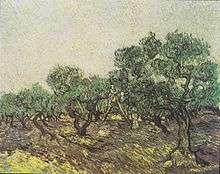
December 1889
73 x 92 cm
Private Collection in Switzerland (F654)
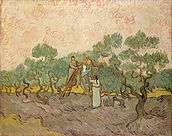
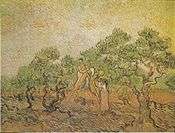
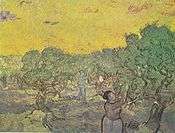
December 1889
Kröller-Müller Museum, Otterlo, Netherlands (F587)
Painted in May and June 1889
Van Gogh made four paintings in May and June 1889. The first, Couple Walking among Olive Trees in a Mountainous Landscape with Crescent Moon (F704) is located at the Museu de Arte de São Paulo, São Paulo, Brazil.[33]

May 1890
49.5 x 45.5
Museu de Arte de São Paulo, São Paulo, Brazil (F704)
Van Gogh identified three olive tree paintings made in June, the second month of his stay at the asylum.[13][19]
The Nelson-Atkins Museum of Art's Olive Orchard (F715) was expressed by van Gogh in a letter of July 1889 as an orchard of olive trees with gray leaves, "their violet shadows lying on the sunny sand." By contrast, the shadows accentuate the heat of the Provençal sun. The "repetitive, rectangular brush strokes" convey an energy that heightens the emotional impact of this work.[34]
Van Gogh Museum's Olive Trees: Bright Blue Sky (F709) of cool, blue daylight tones is similar to Göteborgs Museum of Art's Olive Grove, a study in warm autumn colors. The autumn toned painting met van Gogh's goal of achieving a "harsh and coarse" realism to his work. He presented the painting to his friend and doctor, Dr. Gachet, with whom he would be under care and supervision in Auvers-sur-Oise the following year.[35]
The Kröller-Müller Museum Olive Orchard (F585) was painted in June, 1889.[36]
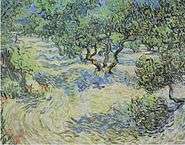

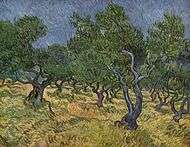
Painted in September, November and December 1889
The paintings made during this period were much the artistic result of van Gogh's reaction to the Gauguin and Bernard Gethsemane painting, as mentioned in the "Spiritual significance" section.[20][37]
The intense nature of National Gallery of Scotland's Olive Trees (F714) likely expresses Van Gogh's agitated state of mind when he completed this work, dramatic impact evidenced both through his brushstrokes and color use.[37]
Contrasting with his June olives with their blue-green color and coolness of tone,[38] the vibrant oranges and yellows in Olive Trees with Yellow Sky and Sun (F710) evoke the fall season.[4] Novelist Warren Keith Wright visited this painting at the Minneapolis Institute of Art over a 15-year period, transfixed by the painting, but unsure why. He came to realize that the fascination was that the painting represented two periods of time. The late-afternoon sun lies due west above the mountains. The shadows, though, slant from the left, or the southwest, where they would fall in autumn. Not only is the painting out of sync with time, it is also out of sync with the season. It "predicts its own future, reverts to its own past."[39]
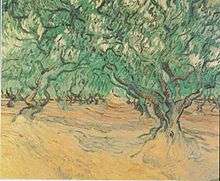
September 1889
Private Collection (F711)
.jpg)
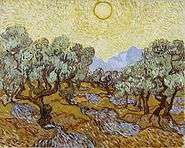
November 1889
73.6 x 92.7 cm
Minneapolis Institute of Arts, Minneapolis (F710)
In November or December 1889 Van Gogh worked on Olive Orchard, MoMA (F708). Another painting from this time is Olive Grove: Orange Sky (F586) which resides at the Göteborgs Museum of Art, Gothenburg, Sweden.[35]
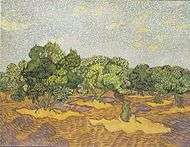
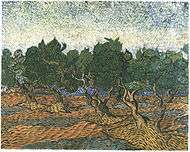

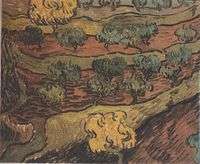
November–December 1889
33.5 x 40.0 cm
Van Gogh Museum, Amsterdam (F716)
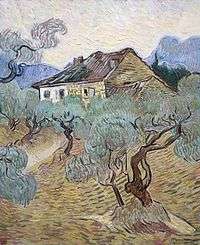
December 1889
70 x 60
Private collection (F664)

December 1889
45 x 55 cm
Location unknown (F663)
References
- ↑ "The Olive Trees". The Collection. Museum of Modern Art. Retrieved 20 February 2012.
- ↑ Brooks, D. "Olive Trees with the Alpilles in the Background". The Vincent van Gogh Gallery, endorsed by Van Gogh Museum, Amsterdam. David Brooks (self-published).
- 1 2 3 "Heilbrunn Timeline of Art History". Thematic Essay, Vincent van Gogh. The Metropolitan Museum of Art. 2000–2011. Retrieved March 25, 2011.
- 1 2 "Olive Trees, 1889, van Gogh". Collection. Minneapolis Institute of Arts. Retrieved March 25, 2011.
- ↑ "Olive Trees, 1889, van Gogh". Collection. The Metropolitan Museum of Art. 2000–2011. Retrieved March 25, 2011.
- 1 2 3 "The Therapy of Painting". Van Gogh Museum. Retrieved March 25, 2011.
- ↑ Wallace (1969). Editors of Time-Life Books, ed. The World of Van Gogh (1853-1890). Alexandria, VA: Time-Life Books. pp. 139–146.
- 1 2 Edwards, C (1989). Van Gogh and God: A Creative Spiritual Quest. Chicago: Loyola University Press. p. 113. ISBN 0-8294-0621-2.
- ↑ Mancoff, D (1999). Van Gogh's Flowers. London: Frances Lincoln Limited. p. 20. ISBN 978-0-7112-2908-2.
- 1 2 3 4 "The Olive Garden, 1889". Collection. National Gallery of Art, Washington, DC. 2011. Retrieved March 25, 2011.
- 1 2 "Vincent van Gogh Teaching Program". Education. National Gallery of Art, Washington, D.C. Retrieved March 26, 2011.
- 1 2 Van Gogh, V; Suh, H. (2006). Vincent van Gogh: A Self-Portrait in Art and Letters. New York: Black Dog & Leventhal Publishers. p. 294.
- 1 2 3 4 5 6 7 8 9 10 Leeuw, R (1997) [1996]. van Crimpen, H; Berends-Albert, M, eds. The Letters of Vincent van Gogh. London and other locations: Penguin Books.
- 1 2 Wallace (1969). Editors of Time-Life Books, ed. The World of Van Gogh (1853-1890). Alexandria, VA: Time-Life Books. pp. 12–15.
- ↑ Edwards, C (1989). Van Gogh and God: A Creative Spiritual Quest. Chicago: Loyola University Press. p. 103. ISBN 0-8294-0621-2.
- ↑ Edwards, C (1989). Van Gogh and God: A Creative Spiritual Quest. Chicago: Loyola University Press. p. 70. ISBN 0-8294-0621-2.
- ↑ "Émile Bernard Christ in the Garden of Olives". Indianapolis Museum of Art. Retrieved July 26, 2016.
- ↑ Margolis Maurer, Naomi. "The Pursuit of Spiritual Wisdom: Thought and Art of Vincent van Gogh and Paul Gauguin". Madison, NJ: Fairleigh Dickinson University Press, 1998. ISBN 0-8386-3749-3
- 1 2 3 4 5 SAS. "Europe 1700-1900" (PDF). The Metropolitan Museum of Art Bulletin. The Metropolitan Museum of Art and JSTOR: 46. Retrieved March 25, 2011.
- 1 2 3 Nordenfalk, C (2006). The Life and Work of Van Gogh. New York: Philosophical Library. p. 177.
- ↑ Silverman, Debora. Van Gogh and Gauguin: The Search for Sacred Art p.311 Retrieved May 9, 2011
- ↑ Lubin, A (1996) [1972]. Stranger on the Earth: A Psychological Biography of Vincent van Gogh. United States: De Capo Press. pp. 74–75. ISBN 0-306-80726-2.
- 1 2 H. W. Janson (1971). "The Modern World". A Basic History of Art. New York: Harry N. Abrams. p. 308. ISBN 0-13-389296-4.
- ↑ Morton, M; Schmunk, P (2000). The Arts Entwined: Music and Painting in the Nineteenth Century. New York: Garland Publishing. pp. 177–178. ISBN 0-8153-3156-8.
- ↑ Erickson, K (1998). At Eternity's Gate: The Spiritual Vision Of Vincent van Gogh. Grand Rapids, MI: William B. Eerdsmans Publishing. pp. 82, 149.
- ↑ Du Quesne-van Gogh, E (1913). Personal Recollections of Vincent van Gogh. Boston and New York: Houghton Mifflin Company. p. 16.
- ↑ Jethani, S (2009). The Divine Commodity: Discovering a Faith Beyond Consumer Christianity. Grand Rapids, MI: Zondervan (eBook). ISBN 978-0-310-57422-4.
- ↑ "Olive Trees". Van Gogh Saint-Rémy paintings. Van Gogh Gallery. Retrieved March 27, 2011This site is sanctioned by the Van Gogh Museum of Amsterdam, The Netherlands
- 1 2 Poore, H (1976) [1967 by Sterling Publishing, NY]. Composition in Art. Mineola, NY: Dover Publications. p. 36.
- 1 2 "Olive Trees, June–July 1889". Painting and Sculpture, Vincent van Gogh. Museum of Modern Art. 2010. Retrieved March 25, 2011The text on the page is referenced to The Museum of Modern Art, MoMA Highlights, New York: The Museum of Modern Art, revised 2004, originally published 1999, p. 34
- ↑ "Women Picking Olives". Collection. The Metropolitan Museum of Art. 2000–2011. Retrieved March 25, 2011.
- ↑ "Olive Grove with Two Olive Pickers". Collection. Kröller-Müller Museum. Retrieved March 25, 2011.
- ↑ "Passeio ao Crepúsculo (Couple Walking among Olive Trees in a Mountainous Landscape with Crescent Moon)". Arte Francesa (French Art). Museu de Arte de São Paulo. Retrieved March 25, 2011.
- ↑ "Olive Orchard". Collections. Nelson Atkins Museum of Art. 2010. Retrieved March 26, 2011.
- 1 2 "Olive Grove, Saint-Rémy, 1889". Collection. Gõteborg, Sweden: Göteborgs Museum of Art. Retrieved March 25, 2011.
- ↑ "Olive Grove". Collection. Kröller-Müller Museum. Retrieved March 25, 2011.
- 1 2 "Olive Trees, 1889". National Gallery of Scotland. Retrieved March 25, 2011.
- ↑ Pickvance, Ronald (1986). Van Gogh in Saint-Rémy and Auvers. Metropolitan Museum of Art. p. 160. ISBN 978-0-87099-477-7.
- ↑ Elkins, James (2004). Pictures & Tears: A History of People Who Have Cried in Front of Paintings. London: Routledge. p. 134. ISBN 0-415-97053-9.
Bibliography
- Du Quesne-van Gogh, E (1913). Personal Recollections of Vincent van Gogh. Boston and New York: Houghton Mifflin Company.
- Edwards, C (1989). Van Gogh and God: A Creative Spiritual Quest. Chicago: Loyola University Press. ISBN 0-8294-0621-2.
- Elkins, James (2004). Pictures & Tears: A History of People Who Have Cried in Front of Paintings. London: Routledge. ISBN 0-415-97053-9.
- Erickson, K (1998). At Eternity's Gate: The Spiritual Vision Of Vincent van Gogh. Grand Rapids, MI: William B. Eerdsmans Publishing.
- Jethani, S (2009). The Divine Commodity: Discovering a Faith Beyond Consumer Christianity. Grand Rapids, MI: Zondervan (eBook). ISBN 978-0-310-57422-4.
- Leeuw, R (1997) [1996]. van Crimpen, H, Berends-Albert, M. ed. The Letters of Vincent van Gogh. London and other locations: Penguin Books.
- Mancoff, D (1999). Van Gogh's Flowers. London: Frances Lincoln Limited. ISBN 978-0-7112-2908-2.
- Nordenfalk, C (2006). The Life and Work of Van Gogh. New York: Philosophical Library.
- Poore, H (1976) [1967 by Sterling Publishing, NY]. Composition in Art. Mineola, NY: Dover Publications.
- Silverman, Debora, (2000) Van Gogh and Gauguin: The Search for Sacred Art. Farrar, Straus and Giroux. ISBN 978-0-374-28243-1.
- Stoesz, D (2010). Glimpses of Grace: Reflections of a Prison Chaplain. Victoria, BC: Friesen Press. ISBN 978-1-77067-179-9.
- Van Gogh, V; Suh, H. (2006). Vincent van Gogh: A Self-Portrait in Art and Letters. New York: Black Dog & Leventhal Publishers.
- Wallace (1969). Editors of Time-Life Books. ed. The World of Van Gogh (1853–1890). Alexandria, VA: Time-Life Books.
External links
- Van Gogh, paintings and drawings: a special loan exhibition, a fully digitized exhibition catalog from The Metropolitan Museum of Art Libraries, which contains material on these paintings (see index)